Cutting-Edge Electrocatalysts for CO2RR
Abstract
1. Introduction
Mechanism for Electrochemical Reduction of CO2
2. Noble Metal-Based Nanosized Catalysts for CO2RR
3. Non-Noble Metal-Based Electrocatalysts for CO2RR
| Electrocatalysts | Support | Main Product | FE (%) | Potential (V vs. RHE) | Reference |
|---|---|---|---|---|---|
| Carbon coated Ni NPs | N-doped carbon | CO | 94 | −0.7 | [25] |
| Ni NPs encapsulated in N-doped carbon nanohybrid substrates | - | CO | 93.1 | −0.9 | [26] |
| NiFe | 2D MOF | CO | 98.2 | −0.5 | [27] |
| Nanoporous NiSe2 | - | CH3COOH | 98.45 | −0.25 | [28] |
| ZnO nanowires | - | CO | 91.6 | −0.62 | [29] |
| Cohcp nanosheets | - | Ethanol | 60 | −0.4 | [30] |
| Co NPs (5 nm) | Single layer nitrogen doped graphene | CH3OH | 71.4 | −0.90 V(SCE) | [31] |
| CoTe nanostructures | - | CH3COOH | 87 | −0.25 | [32] |
| Fe-doped SnO2 electrode | - | HCOOH | 41 | −0.89 | [33] |
| SnO2 NPs (<5 nm) | - | HCOO- | 64 | −1.21 | [34] |
| CuO NPs/TiO2catalyst | TiO2 | EtOH | ~36 | −0.85 | [35] |
4. Copper-Based Catalysts for CO2RR
4.1. Copper-Based Alloys
4.2. Copper Alloyed with Non-Noble Metals
4.2.1. Copper-Based Core/Shell Systems
4.2.2. The Influence of Supports
4.2.3. Crystalline Versus Amorphous Cu Nanoparticles
5. Conclusions
Author Contributions
Funding
Institutional Review Board Statement
Informed Consent Statement
Data Availability Statement
Conflicts of Interest
Sample Availability
References
- Climate Change: Atmospheric Carbon Dioxide|NOAA Climate.gov. Available online: http://www.climate.gov/news-features/understanding-climate/climate-change-atmospheric-carbon-dioxide (accessed on 15 January 2023).
- Global Warming Effects. Available online: https://www.nationalgeographic.com/environment/global-warming/global-warming-effects/ (accessed on 13 October 2020).
- Beneficial Utilisation of Carbon Dioxide|Owner Team Consultation. Available online: https://www.ownerteamconsult.com/beneficial-utilisation-of-carbon-dioxide/ (accessed on 25 January 2023).
- Nakata, K.; Ozaki, T.; Terashima, C.; Fujishima, A.; Einaga, Y. High-Yield Electrochemical Production of Formaldehyde from CO2 and Seawater. Angew. Chem. Int. Ed. 2014, 53, 871–874. [Google Scholar] [CrossRef] [PubMed]
- Ahmad, K.; Upadhyayula, S. Greenhouse Gas CO2 Hydrogenation to Fuels: A Thermodynamic Analysis: Greenhouse Gas CO2 Hydrogenation to Fuels: A Thermodynamic Analysis. Environ. Prog. Sustain. Energy 2019, 38, 98–111. [Google Scholar] [CrossRef]
- Wu, J.; Zhou, X.-D. Catalytic Conversion of CO2 to Value Added Fuels: Current Status, Challenges, and Future Directions. Chin. J. Catal. 2016, 37, 999–1015. [Google Scholar] [CrossRef]
- Lim, R.J.; Xie, M.; Sk, M.A.; Lee, J.-M.; Fisher, A.; Wang, X.; Lim, K.H. A Review on the Electrochemical Reduction of CO2 in Fuel Cells, Metal Electrodes and Molecular Catalysts. Catal. Today 2014, 233, 169–180. [Google Scholar] [CrossRef]
- Liang, S.; Huang, L.; Gao, Y.; Wang, Q.; Liu, B. Electrochemical Reduction of CO2 to CO over Transition Metal/N-Doped Carbon Catalysts: The Active Sites and Reaction Mechanism. Adv. Sci. 2021, 8, 2102886. [Google Scholar] [CrossRef] [PubMed]
- Marcandalli, G.; Monteiro, M.C.O.; Goyal, A.; Koper, M.T.M. Electrolyte Effects on CO2 Electrochemical Reduction to CO. Acc. Chem. Res. 2022, 55, 1900–1911. [Google Scholar] [CrossRef]
- Weekes, D.M.; Salvatore, D.A.; Reyes, A.; Huang, A.; Berlinguette, C.P. Electrolytic CO2 Reduction in a Flow Cell. Acc. Chem. Res. 2018. [Google Scholar] [CrossRef] [PubMed]
- Luo, W.; Zhang, J.; Li, M.; Züttel, A. Boosting CO Production in Electrocatalytic CO2 Reduction on Highly Porous Zn Catalysts. ACS Catal. 2019, 9, 3783–3791. [Google Scholar] [CrossRef]
- Garza, A.J.; Bell, A.T.; Head-Gordon, M. Mechanism of CO2 Reduction at Copper Surfaces: Pathways to C2 Products. ACS Catal. 2018, 8, 1490–1499. [Google Scholar] [CrossRef]
- Zhu, W.; Michalsky, R.; Metin, Ö.; Lv, H.; Guo, S.; Wright, C.J.; Sun, X.; Peterson, A.A.; Sun, S. Monodisperse Au Nanoparticles for Selective Electrocatalytic Reduction of CO2 to CO. J. Am. Chem. Soc. 2013, 135, 16833–16836. [Google Scholar] [CrossRef]
- Lu, Q.; Rosen, J.; Zhou, Y.; Hutchings, G.S.; Kimmel, Y.C.; Chen, J.G.; Jiao, F. A Selective and Efficient Electrocatalyst for Carbon Dioxide Reduction. Nat. Commun. 2014, 5, 3242. [Google Scholar] [CrossRef]
- Klinkova, A.; De Luna, P.; Dinh, C.-T.; Voznyy, O.; Larin, E.M.; Kumacheva, E.; Sargent, E.H. Rational Design of Efficient Palladium Catalysts for Electroreduction of Carbon Dioxide to Formate. ACS Catal. 2016, 6, 8115–8120. [Google Scholar] [CrossRef]
- Martin, N.M.; Velin, P.; Skoglundh, M.; Bauer, M.; Carlsson, P.-A. Catalytic Hydrogenation of CO2 to Methane over Supported Pd, Rh and Ni Catalysts. Catal. Sci. Technol. 2017, 7, 1086–1094. [Google Scholar] [CrossRef]
- Park, S.; Bézier, D.; Brookhart, M. An Efficient Iridium Catalyst for Reduction of Carbon Dioxide to Methane with Trialkylsilanes. J. Am. Chem. Soc. 2012, 134, 11404–11407. [Google Scholar] [CrossRef]
- Gao, D.; Zhou, H.; Wang, J.; Miao, S.; Yang, F.; Wang, G.; Wang, J.; Bao, X. Size-Dependent Electrocatalytic Reduction of CO2 over Pd Nanoparticles. J. Am. Chem. Soc. 2015, 137, 4288–4291. [Google Scholar] [CrossRef]
- Kauffman, D.R.; Alfonso, D.; Matranga, C.; Qian, H.; Jin, R. Experimental and Computational Investigation of Au25 Clusters and CO2: A Unique Interaction and Enhanced Electrocatalytic Activity. J. Am. Chem. Soc. 2012, 134, 10237–10243. [Google Scholar] [CrossRef] [PubMed]
- Zhang, S.; Kang, P.; Meyer, T.J. Nanostructured Tin Catalysts for Selective Electrochemical Reduction of Carbon Dioxide to Formate. J. Am. Chem. Soc. 2014, 136, 1734–1737. [Google Scholar] [CrossRef]
- Tan, D.; Cui, C.; Shi, J.; Luo, Z.; Zhang, B.; Tan, X.; Han, B.; Zheng, L.; Zhang, J.; Zhang, J. Nitrogen-Carbon Layer Coated Nickel Nanoparticles for Efficient Electrocatalytic Reduction of Carbon Dioxide. Nano Res. 2019, 12, 1167–1172. [Google Scholar] [CrossRef]
- Chew, L.M.; Ruland, H.; Schulte, H.J.; Xia, W.; Muhler, M. CO2 Hydrogenation to Hydrocarbons over Iron Nanoparticles Supported on Oxygen-Functionalized Carbon Nanotubes. J. Chem. Sci. 2014, 126, 481–486. [Google Scholar] [CrossRef]
- Jiang, X.; Cai, F.; Gao, D.; Dong, J.; Miao, S.; Wang, G.; Bao, X. Electrocatalytic Reduction of Carbon Dioxide over Reduced Nanoporous Zinc Oxide. Electrochem. Commun. 2016, 68, 67–70. [Google Scholar] [CrossRef]
- Xiao, X.; Xu, Y.; Lv, X.; Xie, J.; Liu, J.; Yu, C. Electrochemical CO2 Reduction on Copper Nanoparticles-Dispersed Carbon Aerogels. J. Colloid Interface Sci. 2019, 545, 1–7. [Google Scholar] [CrossRef]
- Jia, M.; Choi, C.; Wu, T.-S.; Ma, C.; Kang, P.; Tao, H.; Fan, Q.; Hong, S.; Liu, S.; Soo, Y.-L.; et al. Carbon-Supported Ni Nanoparticles for Efficient CO 2 Electroreduction. Chem. Sci. 2018, 9, 8775–8780. [Google Scholar] [CrossRef] [PubMed]
- Yuan, C.-Z.; Li, H.-B.; Jiang, Y.-F.; Liang, K.; Zhao, S.-J.; Fang, X.-X.; Ma, L.-B.; Zhao, T.; Lin, C.; Xu, A.-W. Tuning the Activity of N-Doped Carbon for CO2 Reduction via in Situ Encapsulation of Nickel Nanoparticles into Nano-Hybrid Carbon Substrates. J. Mater. Chem. A 2019, 7, 6894–6900. [Google Scholar] [CrossRef]
- Iqbal, R.; Akbar, M.B.; Ahmad, A.; Hussain, A.; Altaf, N.; Ibraheem, S.; Yasin, G.; Khan, M.A.; Tabish, M.; Kumar, A.; et al. Exploring the Synergistic Effect of Novel Ni-Fe in 2D Bimetallic Metal-Organic Frameworks for Enhanced Electrochemical Reduction of CO2. Adv. Mater. Interfaces 2022, 9, 2101505. [Google Scholar] [CrossRef]
- Saxena, A.; Liyanage, W.P.R.; Kapila, S.; Nath, M. Nickel Selenide as an Efficient Electrocatalyst for Selective Reduction of Carbon Dioxide to Carbon-Rich Products. Catal. Sci. Technol. 2022, 12, 4727–4739. [Google Scholar] [CrossRef]
- Luo, W.; Zhang, Q.; Zhang, J.; Moioli, E.; Zhao, K.; Züttel, A. Electrochemical Reconstruction of ZnO for Selective Reduction of CO2 to CO. Appl. Catal. B Environ. 2020, 273, 119060. [Google Scholar] [CrossRef]
- Yin, J.; Yin, Z.; Jin, J.; Sun, M.; Huang, B.; Lin, H.; Ma, Z.; Muzzio, M.; Shen, M.; Yu, C.; et al. A New Hexagonal Cobalt Nanosheet Catalyst for Selective CO2 Conversion to Ethanal. J. Am. Chem. Soc. 2021, 143, 15335–15343. [Google Scholar] [CrossRef] [PubMed]
- Huang, J.; Guo, X.; Yue, G.; Hu, Q.; Wang, L. Boosting CH3OH Production in Electrocatalytic CO2 Reduction over Partially Oxidized 5 Nm Cobalt Nanoparticles Dispersed on Single-Layer Nitrogen-Doped Graphene. ACS Appl. Mater. Interfaces 2018, 10, 44403–44414. [Google Scholar] [CrossRef] [PubMed]
- Saxena, A.; Singh, H.; Nath, M. Cobalt Telluride Electrocatalyst for Selective Electroreduction of CO2 to Value-Added Chemicals. Mater. Renew. Sustain. Energy 2022, 11, 115–129. [Google Scholar] [CrossRef]
- Savino, U.; Sacco, A.; Bejtka, K.; Castellino, M.; Farkhondehfal, M.A.; Chiodoni, A.; Pirri, F.; Tresso, E. Well Performing Fe-SnO2 for CO2 Reduction to HCOOH. Catal. Commun. 2022, 163, 106412. [Google Scholar] [CrossRef]
- Liang, C.; Kim, B.; Yang, S.; Liu, Y.; Woellner, C.F.; Li, Z.; Vajtai, R.; Yang, W.; Wu, J.; Kenis, P.J.A.; et al. High Efficiency Electrochemical Reduction of CO2 beyond the Two-Electron Transfer Pathway on Grain Boundary Rich Ultra-Small SnO2 Nanoparticles. J. Mater. Chem. A 2018, 6, 10313–10319. [Google Scholar] [CrossRef]
- Yuan, J.; Zhang, J.-J.; Yang, M.-P.; Meng, W.-J.; Wang, H.; Lu, J.-X. CuO Nanoparticles Supported on TiO2 with High Efficiency for CO2 Electrochemical Reduction to Ethanol. Catalysts 2018, 8, 171. [Google Scholar] [CrossRef]
- Mellen, G. Copper Demand & Long-Term Availability—Copper Alliance. Available online: https://copperalliance.org/ (accessed on 5 March 2023).
- Daily Metal Price: Copper Price (USD/Pound) Chart for the Last Month. Available online: https://www.dailymetalprice.com/metalpricecharts.php?c=cu&u=lb&d=20 (accessed on 30 March 2023).
- Zhao, K.; Quan, X. Carbon-Based Materials for Electrochemical Reduction of CO2 to C2+ Oxygenates: Recent Progress and Remaining Challenges. ACS Catal. 2021, 11, 2076–2097. [Google Scholar] [CrossRef]
- Marepally, B.C.; Ampelli, C.; Genovese, C.; Sayah, R.; Veyre, L.; Dalverny, C.; Thieuleux, C.; Quadrelli, E.A.; Perathoner, S.; Centi, G. Supported Metallic Nanoparticles Prepared by an Organometallic Route to Boost the Electrocatalytic Conversion of CO2. J. CO2 Util. 2021, 50, 101613. [Google Scholar] [CrossRef]
- Carbon Nanotubes (CNTs)|Buy Online. Available online: https://www.ossila.com/collections/carbon-nanotubes (accessed on 30 March 2023).
- Graphene Powders|Buy Online for Low Price. Available online: https://www.ossila.com/products/graphene-powders (accessed on 27 March 2023).
- Nanodiamonds, Extra Pure, Grade G02. Available online: https://shop.plasmachem.com/nano-diamonds-and-carbon/32-112-nanodiamonds-extra-pure-grade-g02.html (accessed on 27 March 2023).
- Jia, Y.; Li, F.; Fan, K.; Sun, L. Cu-Based Bimetallic Electrocatalysts for CO2 Reduction. Adv. Powder Mater. 2022, 1, 100012. [Google Scholar] [CrossRef]
- Dewulf, D.W.; Bard, A.J. The Electrochemical Reduction of CO2 to CH4 and C2H4 at Cu/Nafion Electrodes (Solid Polymer Electrolyte Structures). Catal Lett 1988, 1, 73–79. [Google Scholar] [CrossRef]
- Watanabe, M.; Shibata, M.; Kato, A.; Azuma, M.; Sakata, T. Design of Alloy Electrocatalysts for CO2 Reduction: III. The Selective and Reversible Reduction of on Cu Alloy Electrodes. J. Electrochem. Soc. 1991, 138, 3382–3389. [Google Scholar] [CrossRef]
- Yano, J.; Morita, T.; Shimano, K.; Nagami, Y.; Yamasaki, S. Selective Ethylene Formation by Pulse-Mode Electrochemical Reduction of Carbon Dioxide Using Copper and Copper-Oxide Electrodes. J Solid State Electrochem 2007, 11, 554–557. [Google Scholar] [CrossRef]
- Xu, Z.; Lai, E.; Shao-Horn, Y.; Hamad-Schifferli, K. Compositional Dependence of the Stability of AuCu Alloy Nanoparticles. Chem. Commun. 2012, 48, 5626. [Google Scholar] [CrossRef]
- Baturina, O.A.; Lu, Q.; Padilla, M.A.; Xin, L.; Li, W.; Serov, A.; Artyushkova, K.; Atanassov, P.; Xu, F.; Epshteyn, A.; et al. CO2 Electroreduction to Hydrocarbons on Carbon-Supported Cu Nanoparticles. ACS Catal. 2014, 4, 3682–3695. [Google Scholar] [CrossRef]
- Rasul, S.; Anjum, D.H.; Jedidi, A.; Minenkov, Y.; Cavallo, L.; Takanabe, K. A Highly Selective Copper-Indium Bimetallic Electrocatalyst for the Electrochemical Reduction of Aqueous CO2 to CO. Angew. Chem. Int. Ed. 2015, 54, 2146–2150. [Google Scholar] [CrossRef] [PubMed]
- Ren, D.; Ang, B.S.-H.; Yeo, B.S. Tuning the Selectivity of Carbon Dioxide Electroreduction toward Ethanol on Oxide-Derived CuxZn Catalysts. ACS Catal. 2016, 6, 8239–8247. [Google Scholar] [CrossRef]
- Clark, E.L.; Hahn, C.; Jaramillo, T.F.; Bell, A.T. Electrochemical CO2 Reduction over Compressively Strained CuAg Surface Alloys with Enhanced Multi-Carbon Oxygenate Selectivity. J. Am. Chem. Soc. 2017, 139, 15848–15857. [Google Scholar] [CrossRef] [PubMed]
- Zeng, J.; Bejtka, K.; Ju, W.; Castellino, M.; Chiodoni, A.; Sacco, A.; Farkhondehfal, M.A.; Hernández, S.; Rentsch, D.; Battaglia, C.; et al. Advanced Cu-Sn Foam for Selectively Converting CO2 to CO in Aqueous Solution. Appl. Catal. B Environ. 2018, 236, 475–482. [Google Scholar] [CrossRef]
- Yang, D.; Zhu, Q.; Chen, C.; Liu, H.; Liu, Z.; Zhao, Z.; Zhang, X.; Liu, S.; Han, B. Selective Electroreduction of Carbon Dioxide to Methanol on Copper Selenide Nanocatalysts. Nat. Commun. 2019, 10, 677. [Google Scholar] [CrossRef]
- Li, D.; Liu, T.; Huang, L.; Wu, J.; Li, J.; Zhen, L.; Feng, Y. Selective CO2-to-Formate Electrochemical Conversion with Core–Shell Structured Cu2O/Cu@C Composites Immobilized on Nitrogen-Doped Graphene Sheets. J. Mater. Chem. A 2020, 8, 18302–18309. [Google Scholar] [CrossRef]
- Xiong, Y.; Wei, B.; Wu, M.; Hu, B.; Zhu, F.; Hao, J.; Shi, W. Rapid Synthesis of Amorphous Bimetallic Copper-Bismuth Electrocatalysts for Efficient Electrochemical CO2 Reduction to Formate in a Wide Potential Window. J. CO2 Util. 2021, 51, 101621. [Google Scholar] [CrossRef]
- Hussain, N.; Abdelkareem, M.A.; Alawadhi, H.; Begum, S.; Elsaid, K.; Olabi, A.G. Novel Ternary CuO–ZnO–MoS2 Composite Material for Electrochemical CO2 Reduction to Alcohols. J. Power Sources 2022, 549, 232128. [Google Scholar] [CrossRef]
- Yuan, W.; Jeyachandran, N.; Rao, T.; Ghulam Nabi, A.; Bisetto, M.; Di Tommaso, D.; Montini, T.; Giordano, C. Study on the Structure vs Activity of Designed Non-Precious Metal Electrocatalysts for CO2 Conversion. Mater. Lett. 2023, 341, 134167. [Google Scholar] [CrossRef]
- Duan, Y.-X.; Meng, F.-L.; Liu, K.-H.; Yi, S.-S.; Li, S.-J.; Yan, J.-M.; Jiang, Q. Amorphizing of Cu Nanoparticles toward Highly Efficient and Robust Electrocatalyst for CO2 Reduction to Liquid Fuels with High Faradaic Efficiencies. Adv. Mater. 2018, 30, 1706194. [Google Scholar] [CrossRef]
- Nadagouda, M.N.; Varma, R.S. Synthesis of Thermally Stable Carboxymethyl Cellulose/Metal Biodegradable Nanocomposites for Potential Biological Applications. Biomacromolecules 2007, 8, 2762–2767. [Google Scholar] [CrossRef]
- Zhou, R.; Wu, X.; Hao, X.; Zhou, F.; Li, H.; Rao, W. Influences of Surfactants on the Preparation of Copper Nanoparticles by Electron Beam Irradiation. Nucl. Instrum. Methods Phys. Res. Sect. B Beam Interact. Mater. At. 2008, 266, 599–603. [Google Scholar] [CrossRef]
- Muniz-Miranda, M.; Gellini, C.; Giorgetti, E. Surface-Enhanced Raman Scattering from Copper Nanoparticles Obtained by Laser Ablation. J. Phys. Chem. C 2011, 115, 5021–5027. [Google Scholar] [CrossRef]
- Salavati-Niasari, M.; Davar, F. Synthesis of Copper and Copper(I) Oxide Nanoparticles by Thermal Decomposition of a New Precursor. Mater. Lett. 2009, 63, 441–443. [Google Scholar] [CrossRef]
- Mallick, K.; Witcomb, M.J.; Scurrell, M.S. In Situ Synthesis of Copper Nanoparticles and Poly(o-Toluidine): A Metal–Polymer Composite Material. Eur. Polym. J. 2006, 42, 670–675. [Google Scholar] [CrossRef]
- Solanki, J.N.; Sengupta, R.; Murthy, Z.V.P. Synthesis of Copper Sulphide and Copper Nanoparticles with Microemulsion Method. Solid State Sci. 2010, 12, 1560–1566. [Google Scholar] [CrossRef]
- Chen, S.; Sommers, J.M. Alkanethiolate-Protected Copper Nanoparticles: Spectroscopy, Electrochemistry, and Solid-State Morphological Evolution. J. Phys. Chem. B 2001, 105, 8816–8820. [Google Scholar] [CrossRef]
- Kim, D.; Resasco, J.; Yu, Y.; Asiri, A.M.; Yang, P. Synergistic Geometric and Electronic Effects for Electrochemical Reduction of Carbon Dioxide Using Gold–Copper Bimetallic Nanoparticles. Nat. Commun. 2014, 5, 4948. [Google Scholar] [CrossRef]
- Ma, S.; Sadakiyo, M.; Heima, M.; Luo, R.; Haasch, R.T.; Gold, J.I.; Yamauchi, M.; Kenis, P.J.A. Electroreduction of Carbon Dioxide to Hydrocarbons Using Bimetallic Cu–Pd Catalysts with Different Mixing Patterns. J. Am. Chem. Soc. 2017, 139, 47–50. [Google Scholar] [CrossRef]
- Tan, D.; Zhang, J.; Cheng, X.; Tan, X.; Shi, J.; Zhang, B.; Han, B.; Zheng, L.; Zhang, J. CuxNiy Alloy Nanoparticles Embedded in a Nitrogen–Carbon Network for Efficient Conversion of Carbon Dioxide. Chem. Sci. 2019, 10, 4491–4496. [Google Scholar] [CrossRef]
- Du, X.; Peng, L.; Hu, J.; Peng, Y.; Primo, A.; Li, D.; Albero, J.; Hu, C.; García, H. Synergistic Effect of Cu and Fe Small Nanoparticles Supported on Porous N-Doped Graphitic Framework for Selective Electrochemical CO2 Reduction at Low Overpotential. Nanoscale 2022, 14, 11583–11589. [Google Scholar] [CrossRef] [PubMed]
- Li, Q.; Fu, J.; Zhu, W.; Chen, Z.; Shen, B.; Wu, L.; Xi, Z.; Wang, T.; Lu, G.; Zhu, J.; et al. Tuning Sn-Catalysis for Electrochemical Reduction of CO2 to CO via the Core/Shell Cu/SnO2 Structure. J. Am. Chem. Soc. 2017, 139, 4290–4293. [Google Scholar] [CrossRef]
- Su, X.; Sun, Y.; Jin, L.; Zhang, L.; Yang, Y.; Kerns, P.; Liu, B.; Li, S.; He, J. Hierarchically Porous Cu/Zn Bimetallic Catalysts for Highly Selective CO2 Electroreduction to Liquid C2 Products. Appl. Catal. B Environ. 2020, 269, 118800. [Google Scholar] [CrossRef]
- Li, H.; Yue, X.; Che, J.; Xiao, Z.; Yu, X.; Sun, F.; Xue, C.; Xiang, J. High Performance 3D Self-Supporting Cu−Bi Aerogels for Electrocatalytic Reduction of CO2 to Formate. ChemSusChem 2022, 15, e202200226. [Google Scholar] [CrossRef] [PubMed]
- Jenkins, J.A.; Wax, T.J.; Zhao, J. Seed-Mediated Synthesis of Gold Nanoparticles of Controlled Sizes To Demonstrate the Impact of Size on Optical Properties. J. Chem. Educ. 2017, 94, 1090–1093. [Google Scholar] [CrossRef]
- Podlesnaia, E.; Csáki, A.; Fritzsche, W. Time Optimization of Seed-Mediated Gold Nanotriangle Synthesis Based on Kinetic Studies. Nanomaterials 2021, 11, 1049. [Google Scholar] [CrossRef]
- Zhang, S.; Zhao, S.; Qu, D.; Liu, X.; Wu, Y.; Chen, Y.; Huang, W. Electrochemical Reduction of CO2 Toward C2 Valuables on Cu@Ag Core-Shell Tandem Catalyst with Tunable Shell Thickness. Small 2021, 17, 2102293. [Google Scholar] [CrossRef]
- Kim, C.; Jeon, H.S.; Eom, T.; Jee, M.S.; Kim, H.; Friend, C.M.; Min, B.K.; Hwang, Y.J. Achieving Selective and Efficient Electrocatalytic Activity for CO2 Reduction Using Immobilized Silver Nanoparticles. J. Am. Chem. Soc. 2015, 137, 13844–13850. [Google Scholar] [CrossRef]
- Wan, L.; Zhang, X.; Cheng, J.; Chen, R.; Wu, L.; Shi, J.; Luo, J. Bimetallic Cu–Zn Catalysts for Electrochemical CO2 Reduction: Phase-Separated versus Core–Shell Distribution. ACS Catal. 2022, 12, 2741–2748. [Google Scholar] [CrossRef]
- Li, C.W.; Ciston, J.; Kanan, M.W. Electroreduction of Carbon Monoxide to Liquid Fuel on Oxide-Derived Nanocrystalline Copper. Nature 2014, 508, 504–507. [Google Scholar] [CrossRef]
- Kuhl, K.P.; Hatsukade, T.; Cave, E.R.; Abram, D.N.; Kibsgaard, J.; Jaramillo, T.F. Electrocatalytic Conversion of Carbon Dioxide to Methane and Methanol on Transition Metal Surfaces. J. Am. Chem. Soc. 2014, 136, 14107–14113. [Google Scholar] [CrossRef]
- Wang, P.; Yang, H.; Xu, Y.; Huang, X.; Wang, J.; Zhong, M.; Cheng, T.; Shao, Q. Synergized Cu/Pb Core/Shell Electrocatalyst for High-Efficiency CO2 Reduction to C2+ Liquids. ACS Nano 2021, 15, 1039–1047. [Google Scholar] [CrossRef]
- Tan, K.H.; Tajuddin, H.A.; Johan, M.R. Feasibility Study on the Use of the Seeding Growth Technique in Producing a Highly Stable Gold Nanoparticle Colloidal System. J. Nanomater. 2015, 2015, e537125. [Google Scholar] [CrossRef]
- da Silva, A.G.M.; Rodrigues, T.S.; Haigh, S.J.; Camargo, P.H.C. Galvanic Replacement Reaction: Recent Developments for Engineering Metal Nanostructures towards Catalytic Applications. Chem. Commun. 2017, 53, 7135–7148. [Google Scholar] [CrossRef] [PubMed]
- Luc, W.; Collins, C.; Wang, S.; Xin, H.; He, K.; Kang, Y.; Jiao, F. Ag–Sn Bimetallic Catalyst with a Core–Shell Structure for CO2 Reduction. J. Am. Chem. Soc. 2017, 139, 1885–1893. [Google Scholar] [CrossRef] [PubMed]
- Xie, H.; Chen, S.; Ma, F.; Liang, J.; Miao, Z.; Wang, T.; Wang, H.-L.; Huang, Y.; Li, Q. Boosting Tunable Syngas Formation via Electrochemical CO2 Reduction on Cu/In2O3 Core/Shell Nanoparticles. ACS Appl. Mater. Interfaces 2018, 10, 36996–37004. [Google Scholar] [CrossRef]
- 4.1. Hydrothermal/Solvothermal Method. Available online: https://bio-protocol.org/exchange/minidetail?type=30&id=9036714 (accessed on 13 February 2023).
- Sun, K.; Cheng, T.; Wu, L.; Hu, Y.; Zhou, J.; Maclennan, A.; Jiang, Z.; Gao, Y.; Goddard, W.A.I.; Wang, Z. Ultrahigh Mass Activity for Carbon Dioxide Reduction Enabled by Gold–Iron Core–Shell Nanoparticles. J. Am. Chem. Soc. 2017, 139, 15608–15611. [Google Scholar] [CrossRef] [PubMed]
- Jiménez, C.; Cerrillo, M.I.; Martínez, F.; Camarillo, R.; Rincón, J. Effect of Carbon Support on the Catalytic Activity of Copper-Based Catalyst in CO2 Electroreduction. Sep. Purif. Technol. 2020, 248, 117083. [Google Scholar] [CrossRef]
- Li, Q.; Zhu, W.; Fu, J.; Zhang, H.; Wu, G.; Sun, S. Controlled Assembly of Cu Nanoparticles on Pyridinic-N Rich Graphene for Electrochemical Reduction of CO2 to Ethylene. Nano Energy 2016, 24, 1–9. [Google Scholar] [CrossRef]
- Single Walled Carbon Nanotubes. Cheap Tubes. Available online: https://www.cheaptubes.com/product-category/single-walled-carbon-nanotubes/ (accessed on 26 March 2023).
- Yang, Q.; Wu, Q.; Liu, Y.; Luo, S.; Wu, X.; Zhao, X.; Zou, H.; Long, B.; Chen, W.; Liao, Y.; et al. Novel Bi-Doped Amorphous SnOx Nanoshells for Efficient Electrochemical CO2 Reduction into Formate at Low Overpotentials. Adv. Mater. 2020, 32, 2002822. [Google Scholar] [CrossRef]
- Yin, P.-F.; Fu, J.; Yun, Q.; Chen, B.; Liu, G.; Li, L.; Huang, Z.; Ge, Y.; Zhang, H. Preparation of Amorphous SnO2-Encapsulated Multiphased Crystalline Cu Heterostructures for Highly Efficient CO2 Reduction. Adv. Mater. 2022, 34, 2201114. [Google Scholar] [CrossRef] [PubMed]
- Wang, Z.; Yuan, Q.; Shan, J.; Jiang, Z.; Xu, P.; Hu, Y.; Zhou, J.; Wu, L.; Niu, Z.; Sun, J.; et al. Highly Selective Electrocatalytic Reduction of CO2 into Methane on Cu–Bi Nanoalloys. J. Phys. Chem. Lett. 2020, 11, 7261–7266. [Google Scholar] [CrossRef]
- Wang, C.; Cao, M.; Jiang, X.; Wang, M.; Shen, Y. A Catalyst Based on Copper-Cadmium Bimetal for Electrochemical Reduction of CO2 to CO with High Faradaic Efficiency. Electrochim. Acta 2018, 271, 544–550. [Google Scholar] [CrossRef]
- He, C.; Wang, S.; Jiang, X.; Hu, Q.; Yang, H.; He, C. Bimetallic Cobalt–Copper Nanoparticle-Decorated Hollow Carbon Nanofibers for Efficient CO2 Electroreduction. Front. Chem. 2022, 10, 904241. [Google Scholar] [CrossRef]
- Saxena, A.; Kapila, S.; Medvedeva, J.E.; Nath, M. Copper Cobalt Selenide as a Bifunctional Electrocatalyst for the Selective Reduction of CO2 to Carbon-Rich Products and Alcohol Oxidation. ACS Appl. Mater. Interfaces 2023, 15, 14433–14446. [Google Scholar] [CrossRef]
- Bernal, M.; Bagger, A.; Scholten, F.; Sinev, I.; Bergmann, A.; Ahmadi, M.; Rossmeisl, J.; Cuenya, B.R. CO2 Electroreduction on Copper-Cobalt Nanoparticles: Size and Composition Effect. Nano Energy 2018, 53, 27–36. [Google Scholar] [CrossRef]
- Zhu, M.; Tian, P.; Li, J.; Chen, J.; Xu, J.; Han, Y.-F. Structure-Tunable Copper–Indium Catalysts for Highly Selective CO2 Electroreduction to CO or HCOOH. ChemSusChem 2019, 12, 3955–3959. [Google Scholar] [CrossRef]
- Dai, L.; Qin, Q.; Wang, P.; Zhao, X.; Hu, C.; Liu, P.; Qin, R.; Chen, M.; Ou, D.; Xu, C.; et al. Ultrastable Atomic Copper Nanosheets for Selective Electrochemical Reduction of Carbon Dioxide. Sci. Adv. 2017, 3, e1701069. [Google Scholar] [CrossRef]
- Saxena, A.; Liyanage, W.; Masud, J.; Kapila, S.; Nath, M. Selective Electroreduction of CO2 to Carbon-Rich Products with a Simple Binary Copper Selenide Electrocatalyst. J. Mater. Chem. A 2021, 9, 7150–7161. [Google Scholar] [CrossRef]
- Xiong, W.; Yang, J.; Shuai, L.; Hou, Y.; Qiu, M.; Li, X.; Leung, M.K.H. CuSn Alloy Nanoparticles on Nitrogen-Doped Graphene for Electrocatalytic CO2 Reduction. ChemElectroChem 2019, 6, 5951–5957. [Google Scholar] [CrossRef]
- Lu, Q.; Hutchings, G.S.; Yu, W.; Zhou, Y.; Forest, R.V.; Tao, R.; Rosen, J.; Yonemoto, B.T.; Cao, Z.; Zheng, H.; et al. Highly Porous Non-Precious Bimetallic Electrocatalysts for Efficient Hydrogen Evolution. Nat. Commun. 2015, 6, 6567. [Google Scholar] [CrossRef] [PubMed]
- Guo, X.; Zhang, Y.; Deng, C.; Li, X.; Xue, Y.; Yan, Y.-M.; Sun, K. Composition Dependent Activity of Cu–Pt Nanocrystals for Electrochemical Reduction of CO2. Chem. Commun. 2015, 51, 1345–1348. [Google Scholar] [CrossRef] [PubMed]

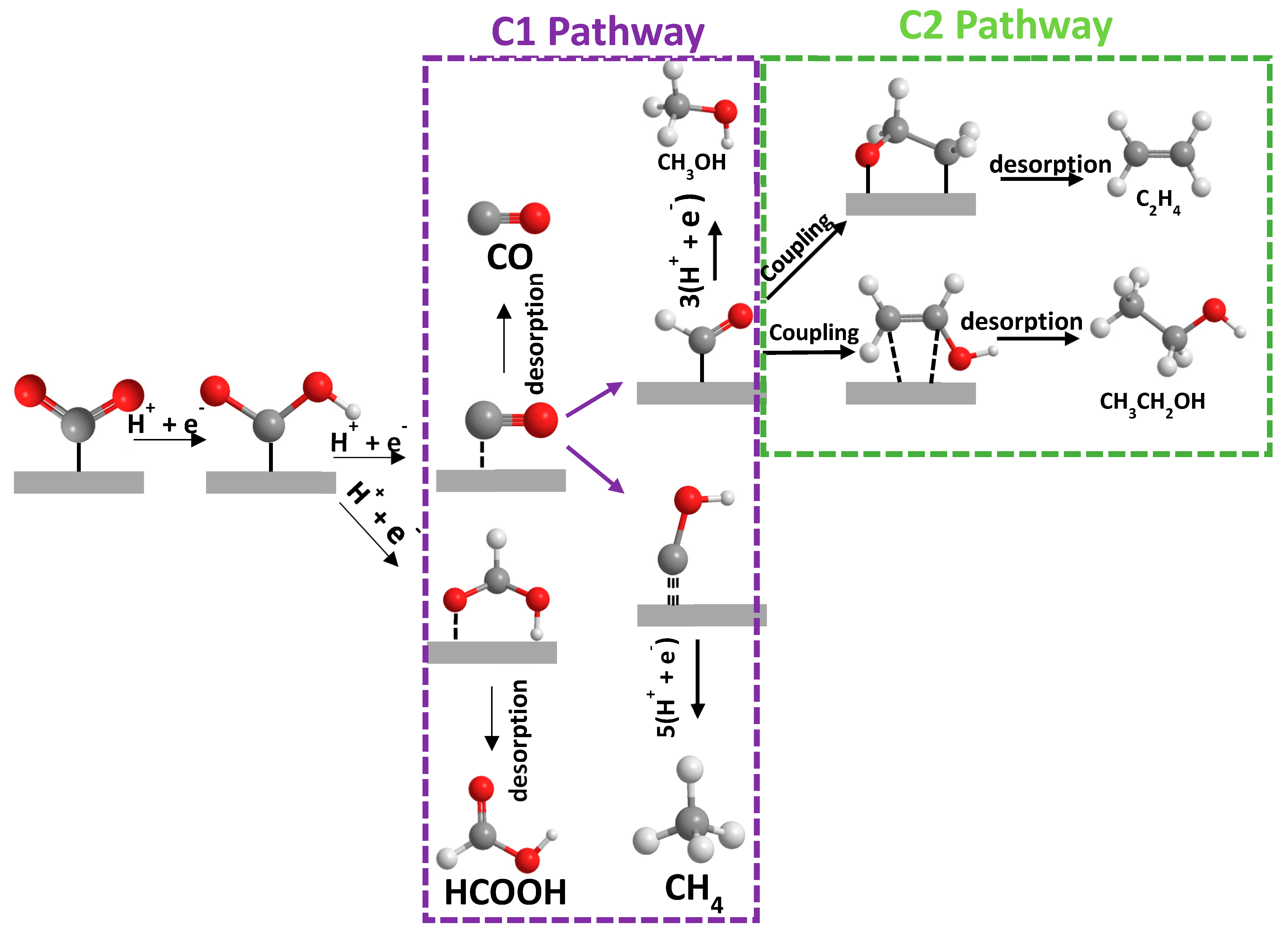
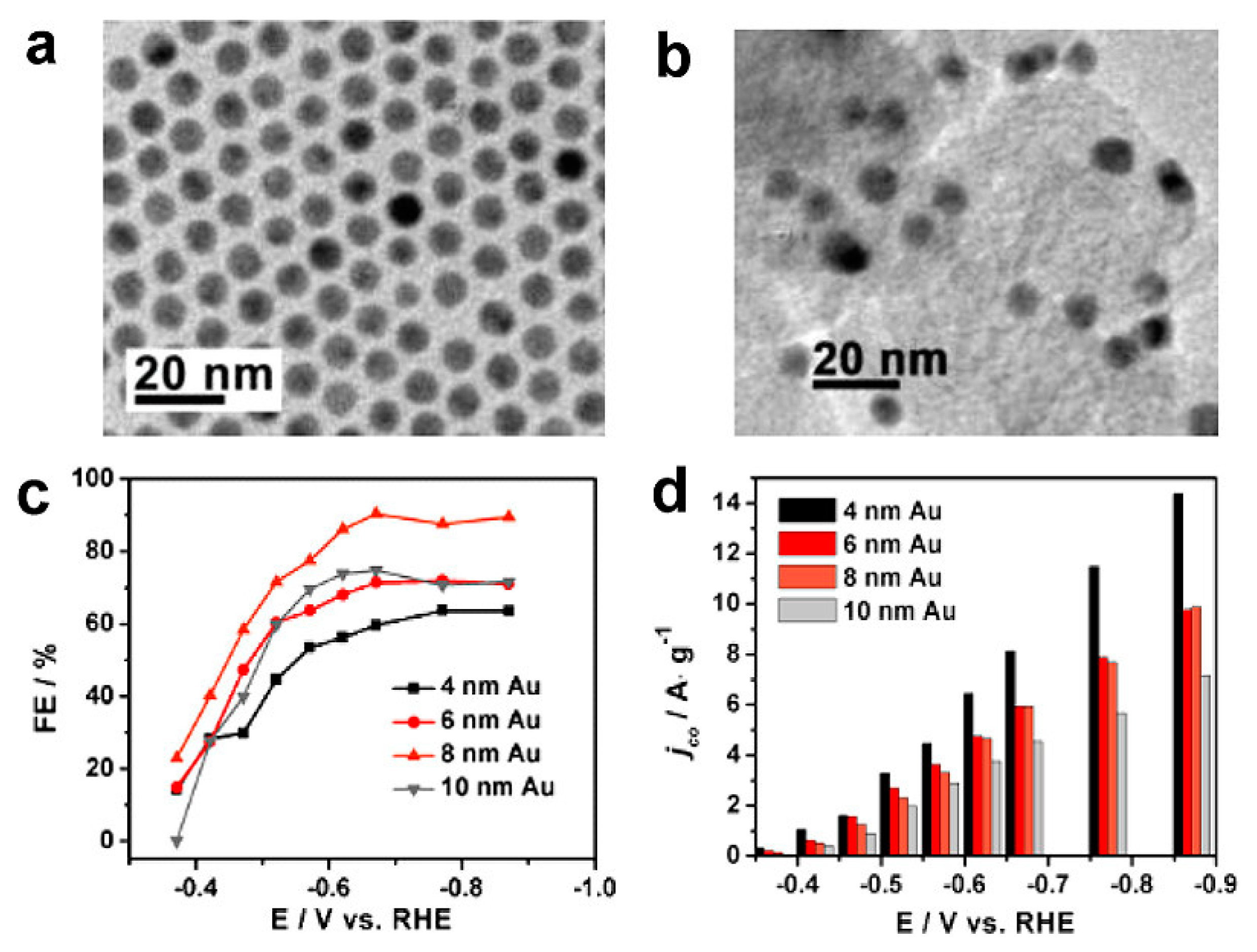
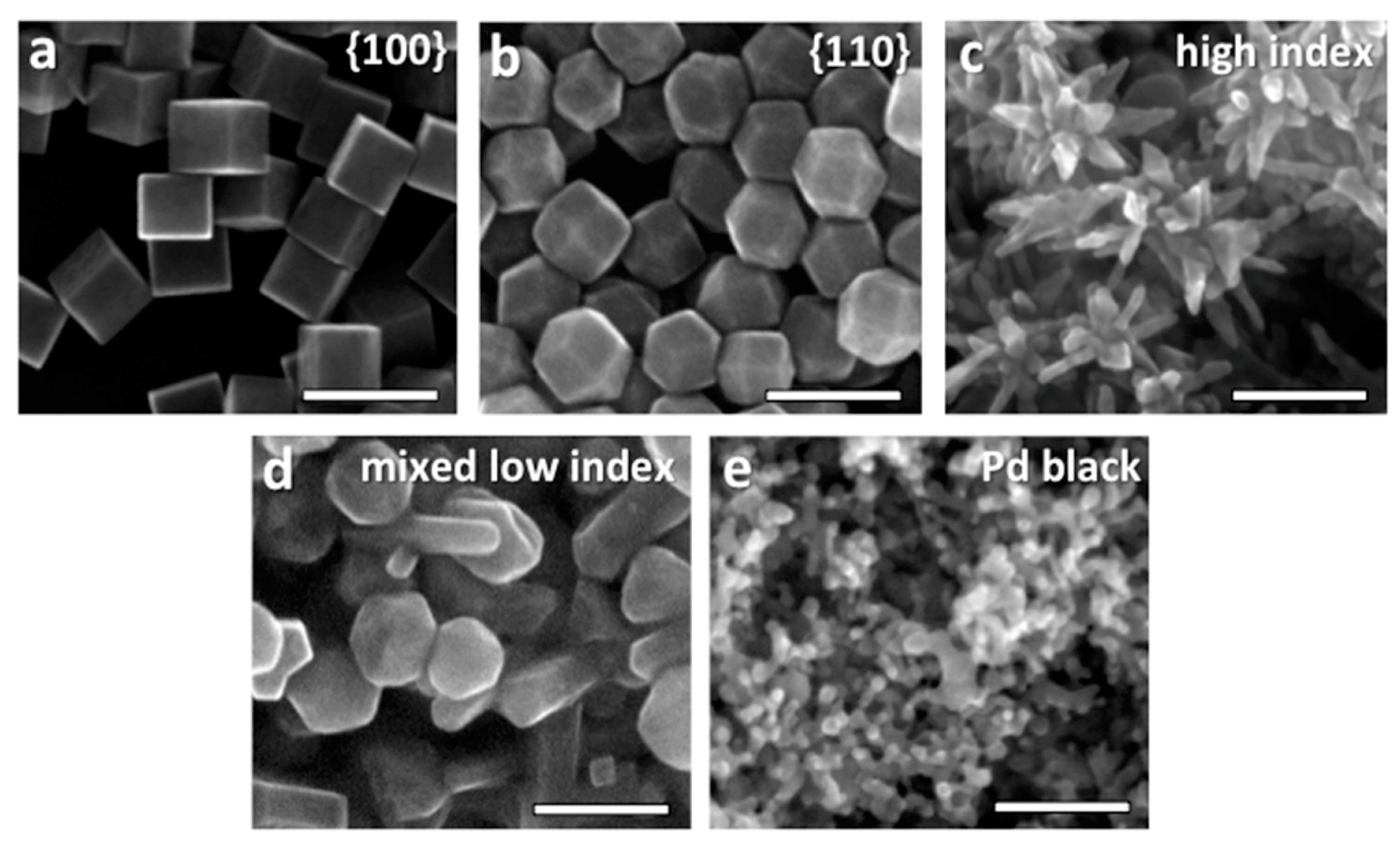
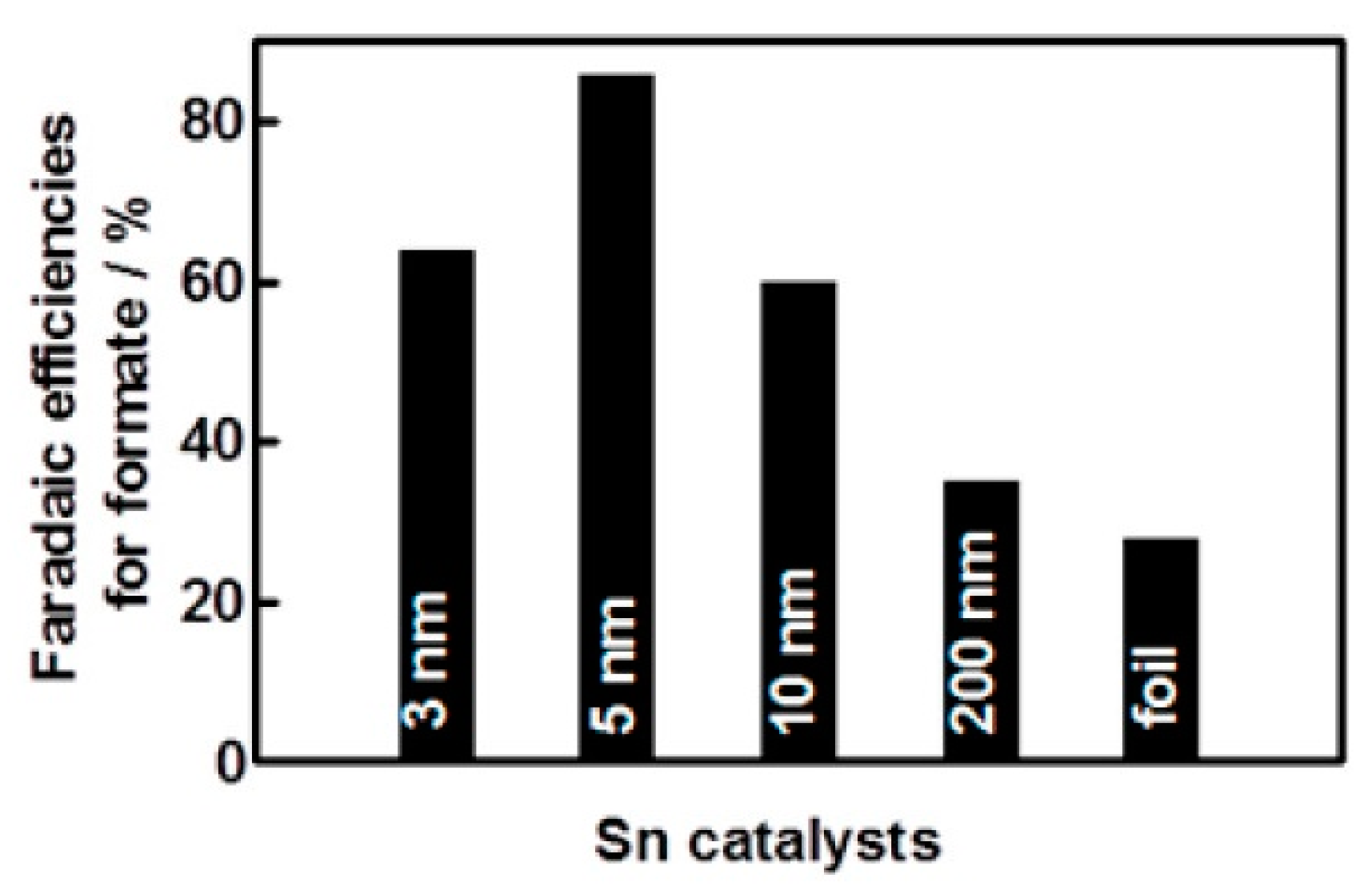
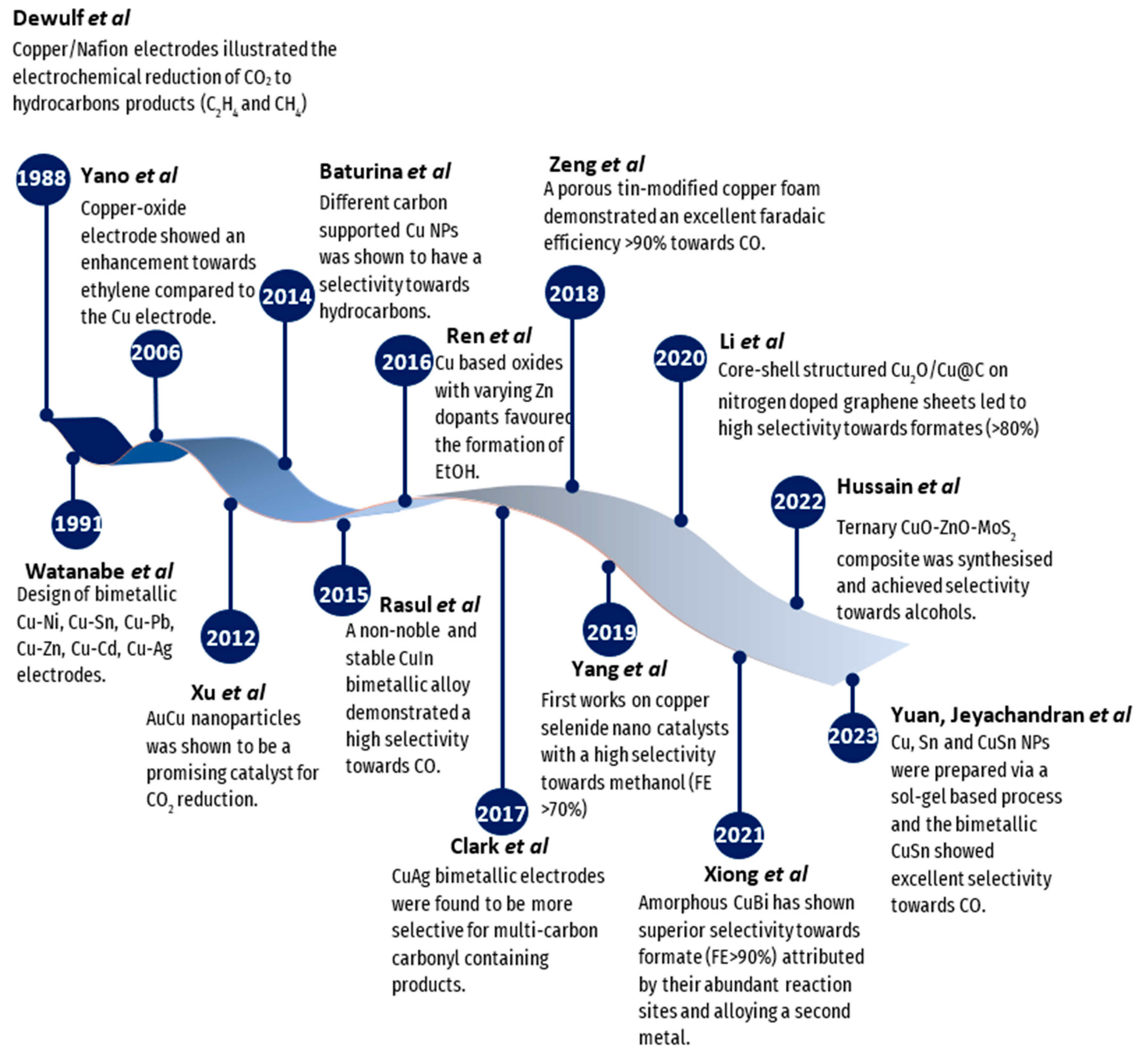

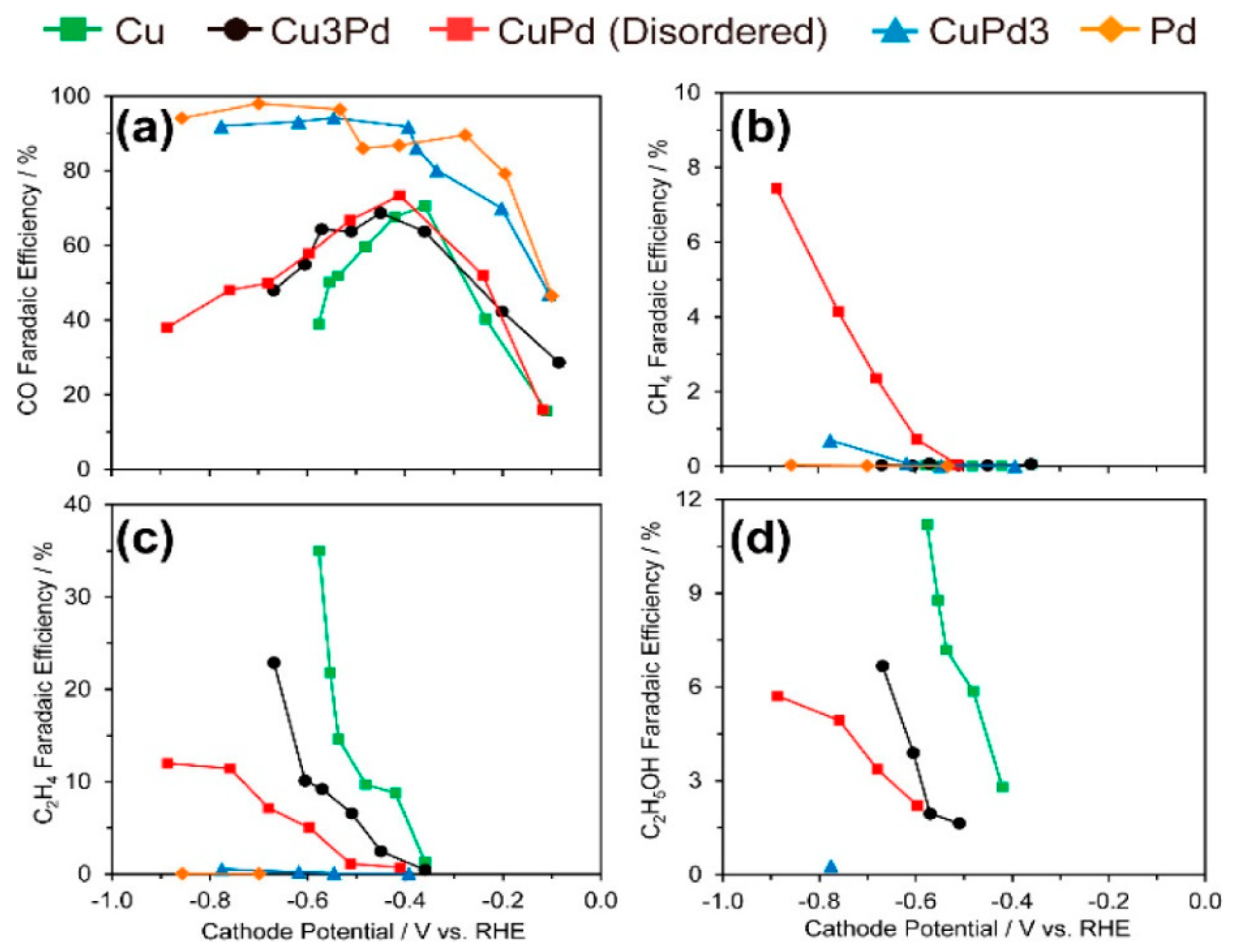
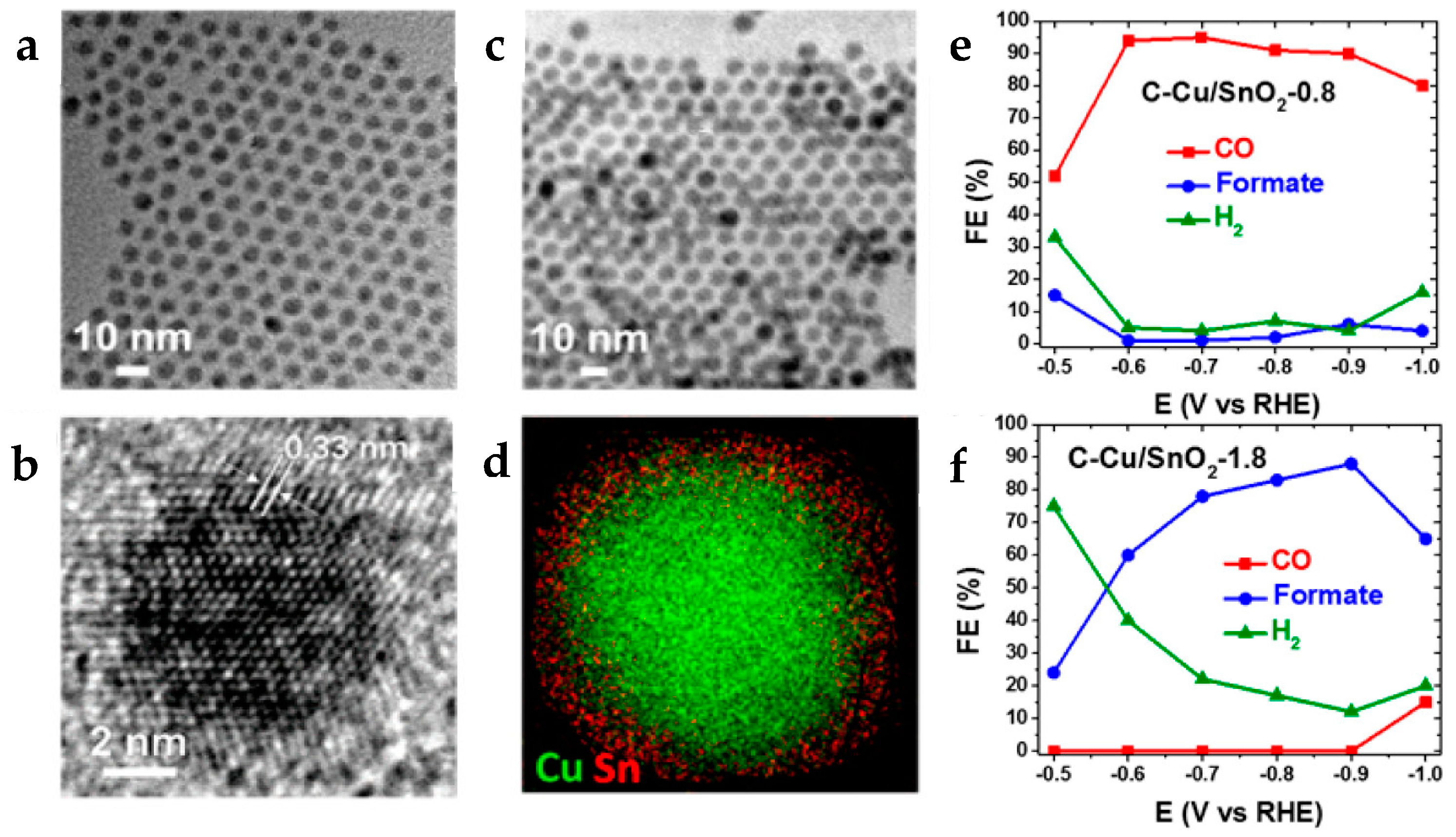
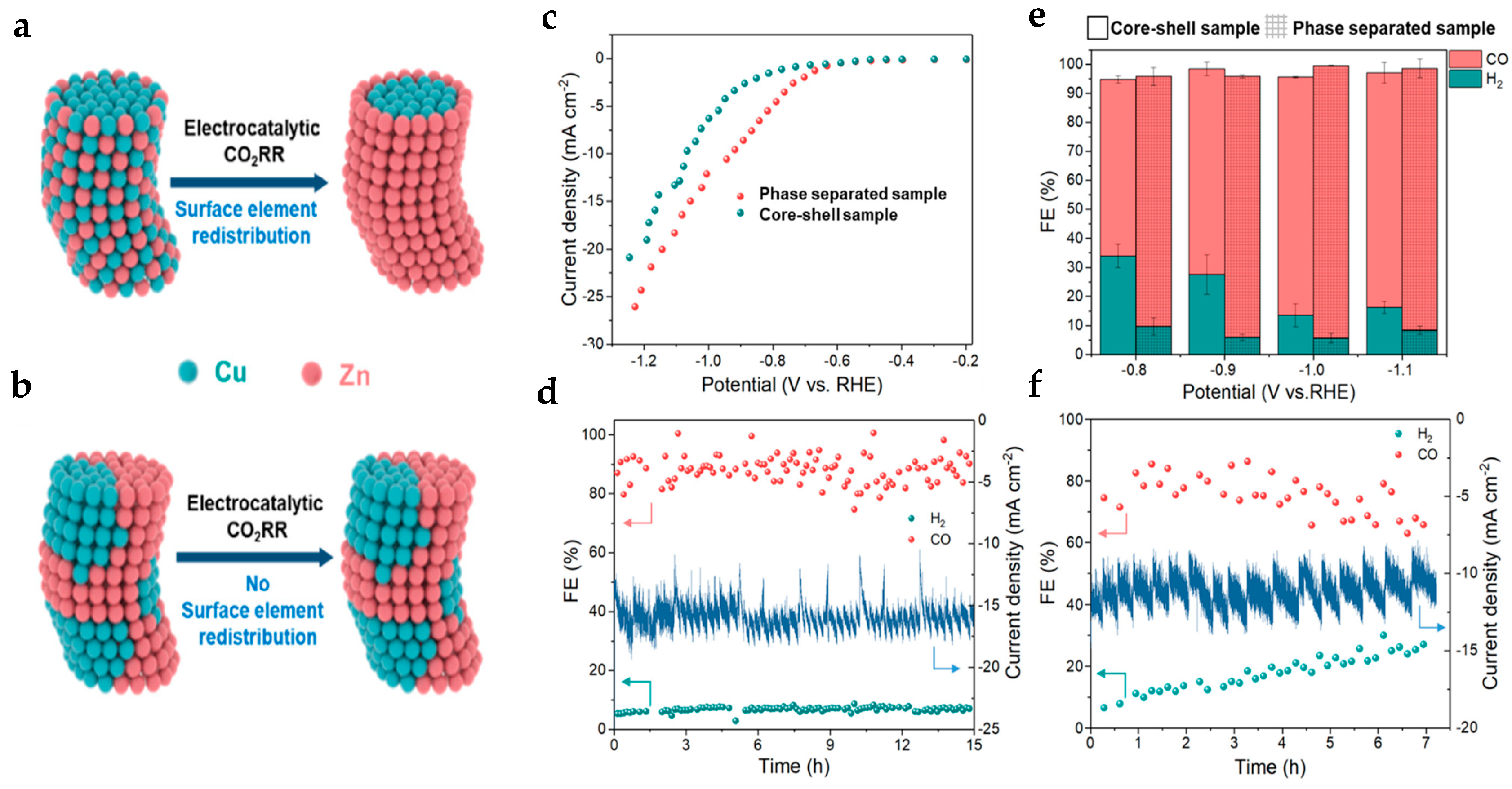
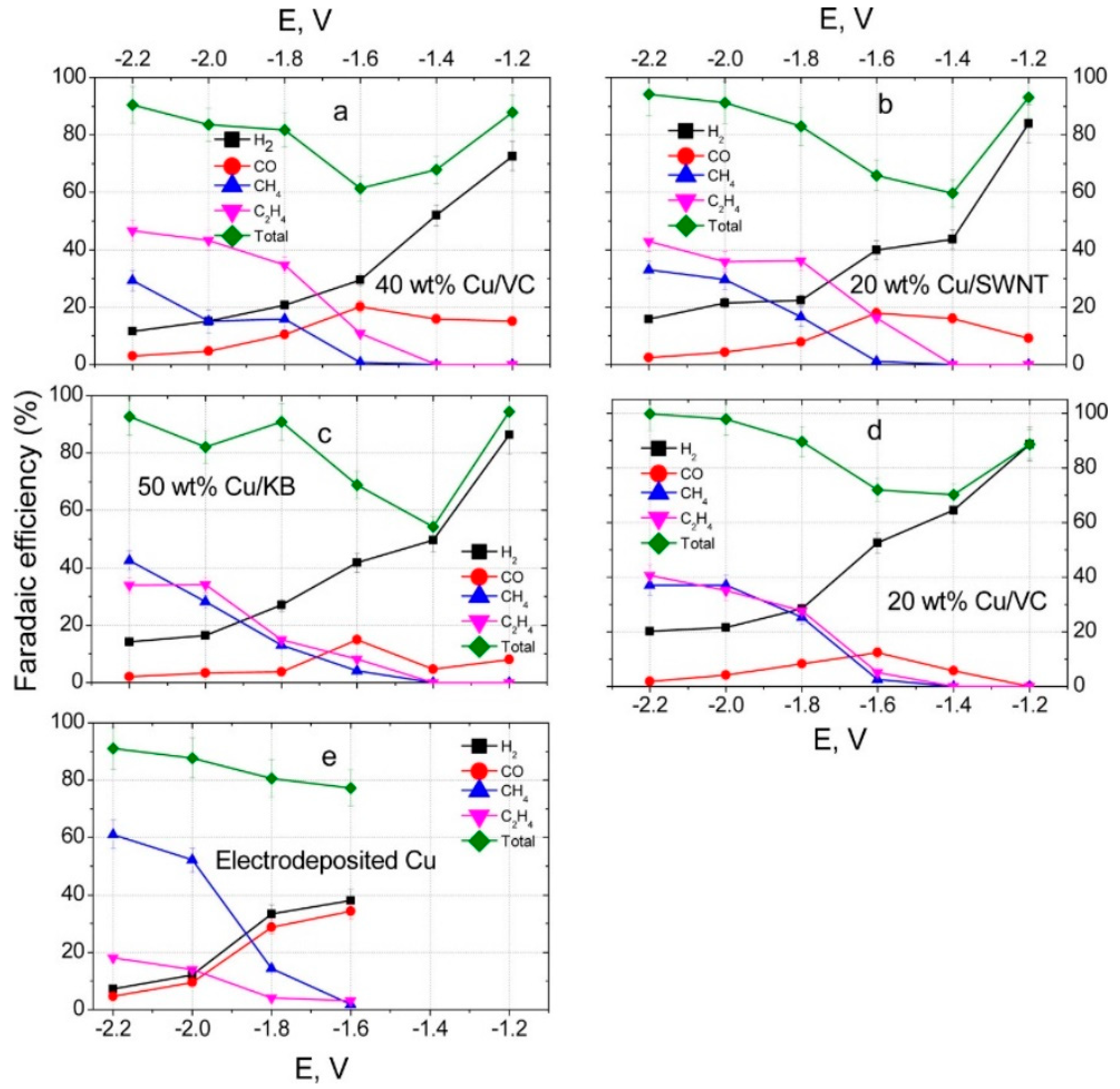
| Reaction | E0/V vs. SHE |
|---|---|
| CO2 + 2H+ + 2e− → CO + H2O | −0.53 |
| CO2 + 2H+ + 2e− → HCOOH | −0.61 |
| CO2 + 6H+ + 6e− → CH3OH + H2O | −0.38 |
| CO2 + 8H+ + 8e− → CH4 + 2H2O | −0.24 |
| 2CO2 + 12H+ + 12e− → C2H4 + 4H2O | −0.34 |
| Electrocatalysts | Main Product | FE (%) | Potential (V vs. RHE) | Reference |
|---|---|---|---|---|
| Au nanoparticles (8 nm) | CO | 90 | −0.67 | [13] |
| Nanoporous Ag | CO | 92 | −0.60 | [14] |
| Branched Pd nanoparticles ~100 nm) | HCOOH | 97 | −0.20 | [15] |
| Pd nanoparticles (3.7 nm) | CO | 91.2 | −0.89 | [18] |
| Rh/Al2O3 | CH4 | - | - | [16] |
| (POCOP)Ir(H)(HSiR3) | CH4 | - | - | [17] |
| Composition | Method | Advantage/Disadvantage of the Synthetic Method | Electrolyte | FE (%) | Potential (V vs. RHE) | Main Product | Ref |
|---|---|---|---|---|---|---|---|
| Cu/Pb nanocrystals | Chemical reduction | Advantages: large-scale production and no chemical purification is required. Disadvantages: size distribution | 1 M KOH | ~33 | 1.3 | C2+ Liquid | [80] |
| Ag3Sn@SnOX NPs | Seed growth and galvanic displacement method | Advantage of seed growth: good control of NP size [81]. Advantages of the galvanic displacement method: fine particle and morphology control [82]. | 0.5 M NaHCO3 | ~80 | −0.8 | Formate | [83] |
| Cu@SnO2 0.8 nm | Seed-mediated method via the decomposition of tin acetylacetonate | Disadvantage: the instability of the seeds [74]. | 0.5 M KHCO3 | 93 | −0.7 | CO | [70] |
| Cu@SnO2 1.8 nm | 85 | −0.9 | Formate | ||||
| Cu@Ag2 core/shell NPs | Two step reduction process | 1.0 M KOH | 32.2 | −1.1 | C2H4 | [75] | |
| Cu/In2O3 | Seed-mediated method via the decomposition of In(acac)3 | 0.5 M KHCO3 | ~70 | −0.7 | CO | [84] | |
| Au-Fe core-shell NPs | Solvothermal method | Advantage: good control in both liquid-phase and multiphase chemical reactions. Disadvantages: expensive and requires high temperatures [85]. | 0.5 M KHCO3 | 97.6 | −0.4 | CO | [86] |
| Composition | Synthetic Method | Electrolyte | FE (%) | Potential (V vs. RHE) | Main Product | Ref |
|---|---|---|---|---|---|---|
| Sn1-xBix alloy NPs with natively bi-doped amorphous SnOx nanoshells | Co-reduction | 0.5 M KHCO3 | 95.8 | −0.88 | Formate | [90] |
| Amorphous CuBi | Electrodeposition method | 0.5 M KHCO3 | >94.7 | −1.0 | Formate | [55] |
| Crystalline Cu@amorphous SnO2 | One pot wet chemical method | 0.1 M KHCO3 | 70 | −1.45 | Formate | [91] |
| Composition | Support (If Any) | FE (%) | Potential (V vs. RHE) | Main Product | Advantages/Disadvantages | Ref |
|---|---|---|---|---|---|---|
| Cu NPs R5 | 11 | −1.5 V vs. Ag/AgCl | CO | Green sol-gel methodology. No use of additives, supports, or co-catalysts. | [57] | |
| Sn NPs R5 | 13 | −1.5 V vs. Ag/AgCl | CO | Green sol-gel methodology. | [57] | |
| CuSn alloy NPs R5 | 19 | −1.5 V vs. Ag/AgCl | CO | Good control of composition and structure for the formation of nano-alloy. | [57] | |
| Cu@Sn-B core/shell NPs R5 | 51 | −1.5 V vs. Ag/AgCl | CO | Good control of composition and structure for the formation of core-shell. | [57] | |
| Sn@Cu-C core/shell NPs R5 | 32 | −1.5 V vs. Ag/AgCl | CO | Good control of composition and structure for the formation of core-shell. | [57] | |
| Cu-Bi NPs | - | 70.6 | −1.2 | CH4 | High potential required. | [92] |
| Cu-Cd | - | 84 | −1.0 | CO | Cd is toxic. | [93] |
| Cu-Co NPs | Carbon nanofibers | 68% | −0.8 | CO | Co is toxic. | [94] |
| CuCo2Se4 | 98 | −0.25 | CH3COOH | The presence of a Co center reduces catalyst poisoning. | [95] | |
| CuCo NPs | - | >85 | −1.1 | H2 | Co is toxic and favors HER | [96] |
| CuFe | Porous N-doped graphitic carbon | 96 | −0.3 | CO | Fe is inexpensive and abundant. | [69] |
| CuIn | Carbon nanotubes | 88.1 | −0.6 | CO | In is unstable, scarce, and expensive. | [97] |
| CuNi NPs | Nitrogen-carbon network | 94.5 | −0.6 | CO | Ni is cheap and non-toxic. | [68] |
| CuNi nanosheet | - | 92 | −0.5 | CO | CuNi nanosheet is air-stable and behaves similarly to Au and Ag. | [98] |
| CuSe2 NPs | 84 | −0.6 | EtOH | [99] | ||
| CuSn NPs Sn NPs | Nitrogen Doped Graphene | 60 54 | −1.0 | HCOO- and CO | Sn is abundant and inexpensive. | [100] |
| Porous CuTi | - | H2 | Favors HER. | [101] | ||
| CuPt nanocrystals | - | −1.6 | H2 | Pt is expensive. Strong affinity between Pt and CO*. Hence, favoring HER over CH4 production. | [102] | |
| CuOx-ZnO phase-separated nanowires CuOx-ZnO Core-shell | - | 94 82 | −1.0 | CO | Zn is inexpensive. | [77] |
| Oxide-derived Cu4Zn | - | 29.1 | −1.05 | C2H5OH | [50] |
Disclaimer/Publisher’s Note: The statements, opinions and data contained in all publications are solely those of the individual author(s) and contributor(s) and not of MDPI and/or the editor(s). MDPI and/or the editor(s) disclaim responsibility for any injury to people or property resulting from any ideas, methods, instructions or products referred to in the content. |
© 2023 by the authors. Licensee MDPI, Basel, Switzerland. This article is an open access article distributed under the terms and conditions of the Creative Commons Attribution (CC BY) license (https://creativecommons.org/licenses/by/4.0/).
Share and Cite
Jeyachandran, N.; Yuan, W.; Giordano, C. Cutting-Edge Electrocatalysts for CO2RR. Molecules 2023, 28, 3504. https://doi.org/10.3390/molecules28083504
Jeyachandran N, Yuan W, Giordano C. Cutting-Edge Electrocatalysts for CO2RR. Molecules. 2023; 28(8):3504. https://doi.org/10.3390/molecules28083504
Chicago/Turabian StyleJeyachandran, Nivetha, Wangchao Yuan, and Cristina Giordano. 2023. "Cutting-Edge Electrocatalysts for CO2RR" Molecules 28, no. 8: 3504. https://doi.org/10.3390/molecules28083504
APA StyleJeyachandran, N., Yuan, W., & Giordano, C. (2023). Cutting-Edge Electrocatalysts for CO2RR. Molecules, 28(8), 3504. https://doi.org/10.3390/molecules28083504






